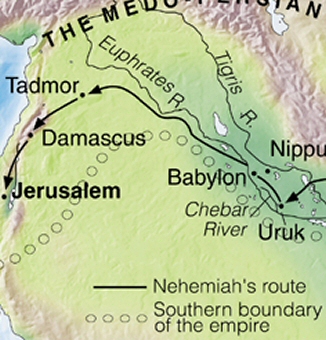Bible Text: Nehemiah 8-9 | Preacher: Pastor Bob Evans | Series: Oakwood Bible Church – Sunday AM |
Book: Nehemiah
Scroll down or click here to view Sermon Audio on this page.
| Common Name: Nehemiah | Book Number: 16 of 66 (Old Testament has 39 Books, New Testament has 27 Books) | Why Written: Documents the history of the Israel’s return from exile and the rebuilding of the walls of Jerusalem. |
| Testament: Old | When Written: 450-400 B.C. Persian Period | Key Phrase: Rebuilding the Nation |
| Category: Historical Books | Where Written: Judah | Key Idea: Honoring God through Dedicated Service |
| Key People: Nehemiah, Ezra, Sanballat, Artaxerxes, Tobiah, Ezra | Key Verse: “Then he said to them, ‘Go your way, eat the fat, drink the sweet, and send portions to those for whom nothing is prepared; for this day is holy to our Lord. Do not sorrow, for the joy of the Lord is your strength.'” (Nehemiah 8:10) | Intended Audience: Nation of Israel as a reminder of what God had done for them. |
Who wrote the book?
Jewish tradition identifies Nehemiah himself as the primary author of this historical book. Much of the book is written from his first-person perspective. Nothing is known about his youth or background; we meet him as an adult serving in the Persian royal court as the personal cupbearer to King Artaxerxes (Nehemiah 1:11–2:1). This prestigious position reveals something of Nehemiah’s upright character. Though he remained in Persia after the exiles had been allowed to go home, he was highly interested in the state of affairs in Judah (his brother Hanani [1:2] had returned there earlier).
The book of Nehemiah could be read as a sequel to the book of Ezra, and some scholars believe the two were originally one work. It is possible that Ezra compiled Nehemiah’s original accounts with other material to create the book of Nehemiah. However, most scholars believe the book was written by Nehemiah.
Where are we?
The book of Nehemiah opens in the Persian city of Susa in the year 444 BC. Later that year, Nehemiah traveled to Israel, leading the third of three returns by the Jewish people following their seventy years of exile in Babylon. (The previous chapter on Ezra describes the earlier two returns.) Most of the book centers on events in Jerusalem. The narrative concludes around the year 430 BC, and scholars believe the book was written shortly thereafter.
Nehemiah is the last historical book of the Old Testament. Although the book of Esther appears after Nehemiah in the canon, the events in Esther occurred in the time period between Ezra 6 and 7, between the first and second returns of the people to Israel. The prophet Malachi was a contemporary of Nehemiah.
Setting:
Zerubbabel led the first return to Jerusalem in 538 B.C. Ezra led the second return in 458 B.C., Then in 445 B.C. Nehemiah returned with the third group of exiles to rebuild the city walls. The setting for this book is the city of Jerusalem as Nehemiah concerned for Jerusalem and its people when he hears about the condition of the city, gets the Persian Kings permission and support to return and rebuild the walls of the once great city.
Why is it so important?
Nehemiah was a layman, not a priest like Ezra nor a prophet like Malachi. He served the Persian king in a secular position before leading a group of Jews to Jerusalem in order to rebuild the city walls. “Nehemiah’s expertise in the king’s court equipped him adequately for the political and physical reconstruction necessary for the remnant to survive.”
Under Nehemiah’s leadership, the Jews withstood opposition and came together to accomplish their goal. Nehemiah led by example, giving up a respected position in a palace for hard labor in a politically insignificant district. He partnered with Ezra, who also appears in this book, to solidify the political and spiritual foundations of the people. Nehemiah’s humility before God (see his moving intercessory prayers in chapters 1 and 9) provided an example for the people. He did not claim glory for himself but always gave God the credit for his successes.
What’s the big idea?
Nehemiah recorded the reconstruction of the wall of Jerusalem, Judah’s capital city. Together, he and Ezra, who led the spiritual revival of the people, directed the political and religious restoration of the Jews in their homeland after the Babylonian captivity.
Nehemiah’s life provides a fine study on leadership. He overcame opposition from outsiders as well as internal turmoil. He exercised his administrative skills in his strategy to use half the people for building while the other half kept watch for the Samaritans who, under Sanballat, threatened attack (Nehemiah 4–7). As governor, Nehemiah negotiated peace among the Jews who were unhappy with Persian taxes. He exhibited a steadfast determination to complete his goals. Accomplishing those goals resulted in a people encouraged, renewed, and excited about their future.
How do I apply this?
The book of Nehemiah shows us the kind of significant impact one individual can have on a nation. Nehemiah served in secular offices, using his position to bring back to the Jews order, stability, and proper focus on God.
God uses all manner of people in all manner of places doing all manner of work. Do you feel you must be “in ministry” in order to serve God? Be encouraged; He is not limited by your vocation. In fact, God has placed you where you are for a purpose. Have this attitude about your work: “Whatever you do in word or deed, do all in the name of the Lord Jesus, giving thanks through Him to God the Father” (Colossians 3:17).
Should a Christian Observe Christmas?
Bible Text: Romans 14:1-6, Jeremiah 10:3-4, Esther 9:22, Nehemiah 8:9-10 | Preacher: Pastor Steve Johnson | Series: Oakwood Bible Church – Sunday AM


